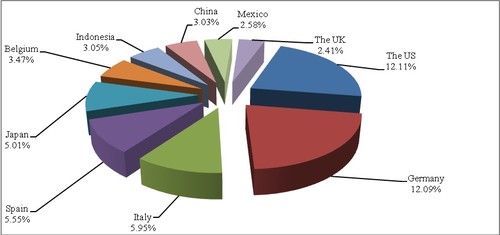(VOVworld) – Coffee is one of Vietnam’s most important agricultural exports. With increasing coffee export output, Vietnam has become a leading world exporter. But Vietnam’s export revenue over the past years haven’t matched up to its potential. VOV’s Pham Duy sheds light on measures to improve the country’s coffee value.
 |
Vietnam’s coffee products export structure by market in first 9 months of 2012
(Source: vietrade.gov.vn) |
Last year, Vietnam earned 3.7 billion USD from selling nearly 1.7 million tons of coffee, accounting for 20% of the world total output. But its value only accounted for 2% of the entire market as most of Vietnam’s exported coffee is unprocessed. Luong Van Tu, President of the Vietnam Coffee – Cacao Association, also blamed the decrease in Vietnamese coffee’s value on its unstable quality due to large areas of old coffee plants and low productivity. Tu suggested that the government and coffee exporters work out more preferential policies to share burdens with farmers in order to grow new varieties and improve quality and productivity. He calls for ‘supporting farmers in terms of capital, means of consuming products, and the process by which we cultivate and harvest coffee crops. Enterprises should ensure outlets for coffee growers. Once this link is established, banks can provide loans for farmers. Once the product is sold, banks can get the money back immediately. Growers, producers, banks, and companies should work together to reap the benefits.’
Many Vietnamese coffee products lack the labels and geographical indications which help consumers better understand about the product and its origin as well as create reliability for customers, according to Trinh Duc Minh, Deputy Director of the Buon Ma Tuot’s Department of Science and Technology. Minh who is also Vice Chairman of the provincial Coffee Association says ‘The association is trying to bring together farmers, producers, and exporters so that the product will display which area it came from when it’s exported to the world market. To realize this, enterprises should organize training-courses for farmers to enable them to set up an internal management system, and learn more about the investment process. Enterprises will only buy the materials when there is accurate information about its origin before processing, packaging, and selling abroad.’
Developing safe coffee products whose quality is certified and internationally guaranteed is a means by which to raise the value of Vietnamese coffee. Currently, only 30% of Vietnamese coffee output has been certified in terms of quality. Dang Kim Son from the Institute for Agriculture Development Strategy comments ‘If we can implement a strategy of quality-certification, we can create a fundamental basis for turning out coffee products of high quality and value. Then we should realize the quality and value by labeling them and developing brands, so that they become known worldwide. To facilitate the process, the government should design supportive policies and conduct trade promotion programs, so helping businesses participate in the global chain.’
The Ministry of Agriculture and Rural Development is building a strategy of sustainable growth for Vietnamese coffee which will help the sector be more successful in the future. In the short term, domestic exporters are trying to improve the management of coffee quality, provide more capital for enterprises and farmers, and increase cooperation and links between processors and exporters in order to diversify export items.
VOV